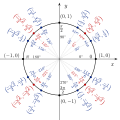Trigonometric functions
Trigonometric Functions
Trigonometric functions are fundamental mathematical functions that relate the angles of a triangle to the lengths of its sides. They are widely used in various fields such as mathematics, physics, engineering, and computer science. The primary trigonometric functions are the sine, cosine, and tangent, which are defined for angles in a right triangle or on the unit circle.
Definitions
The six main trigonometric functions are:
- Sine (sin): In a right triangle, the sine of an angle is the ratio of the length of the opposite side to the hypotenuse.
- Cosine (cos): The cosine of an angle is the ratio of the length of the adjacent side to the hypotenuse.
- Tangent (tan): The tangent of an angle is the ratio of the sine to the cosine, or equivalently, the opposite side to the adjacent side.
- Cosecant (csc): The cosecant is the reciprocal of the sine.
- Secant (sec): The secant is the reciprocal of the cosine.
- Cotangent (cot): The cotangent is the reciprocal of the tangent.
Unit Circle
The unit circle is a circle with a radius of one centered at the origin of the coordinate plane. It is a fundamental tool in trigonometry, allowing the extension of trigonometric functions to all real numbers. The angle in the unit circle is measured from the positive x-axis, and the coordinates of a point on the unit circle are \((\cos \theta, \sin \theta)\).
Periodicity and Symmetry
Trigonometric functions are periodic, meaning they repeat their values in regular intervals. The sine and cosine functions have a period of \(2\pi\), while the tangent and cotangent have a period of \(\pi\). These functions also exhibit symmetry properties:
- Even functions: Cosine and secant are even functions, meaning \(\cos(-\theta) = \cos(\theta)\).
- Odd functions: Sine, tangent, cosecant, and cotangent are odd functions, meaning \(\sin(-\theta) = -\sin(\theta)\).
Graphs
The graphs of trigonometric functions are wave-like and exhibit periodic behavior. The sine and cosine functions produce smooth, continuous waves, while the tangent function has vertical asymptotes and repeats every \(\pi\) radians.
Applications
Trigonometric functions are used in various applications, including:
- Wave analysis: Modeling sound waves, light waves, and other periodic phenomena.
- Engineering: Calculating forces, angles, and distances in mechanical and civil engineering.
- Astronomy: Determining the positions of celestial bodies.
- Computer graphics: Rotating and transforming objects in 3D space.
Related Functions
Trigonometric functions are closely related to the exponential function through Euler's formula, which connects complex exponentials to trigonometric functions:
\[ e^{i\theta} = \cos \theta + i\sin \theta \]
Related Pages
Gallery
- Trigonometric_functions
Transform your life with W8MD's budget GLP-1 injections from $125.
W8MD offers a medical weight loss program to lose weight in Philadelphia. Our physician-supervised medical weight loss provides:
- Most insurances accepted or discounted self-pay rates. We will obtain insurance prior authorizations if needed.
- Generic GLP1 weight loss injections from $125 for the starting dose.
- Also offer prescription weight loss medications including Phentermine, Qsymia, Diethylpropion, Contrave etc.
NYC weight loss doctor appointments
Start your NYC weight loss journey today at our NYC medical weight loss and Philadelphia medical weight loss clinics.
- Call 718-946-5500 to lose weight in NYC or for medical weight loss in Philadelphia 215-676-2334.
- Tags:NYC medical weight loss, Philadelphia lose weight Zepbound NYC, Budget GLP1 weight loss injections, Wegovy Philadelphia, Wegovy NYC, Philadelphia medical weight loss, Brookly weight loss and Wegovy NYC
|
WikiMD's Wellness Encyclopedia |
| Let Food Be Thy Medicine Medicine Thy Food - Hippocrates |
Medical Disclaimer: WikiMD is not a substitute for professional medical advice. The information on WikiMD is provided as an information resource only, may be incorrect, outdated or misleading, and is not to be used or relied on for any diagnostic or treatment purposes. Please consult your health care provider before making any healthcare decisions or for guidance about a specific medical condition. WikiMD expressly disclaims responsibility, and shall have no liability, for any damages, loss, injury, or liability whatsoever suffered as a result of your reliance on the information contained in this site. By visiting this site you agree to the foregoing terms and conditions, which may from time to time be changed or supplemented by WikiMD. If you do not agree to the foregoing terms and conditions, you should not enter or use this site. See full disclaimer.
Credits:Most images are courtesy of Wikimedia commons, and templates, categories Wikipedia, licensed under CC BY SA or similar.
Contributors: Prab R. Tumpati, MD
























